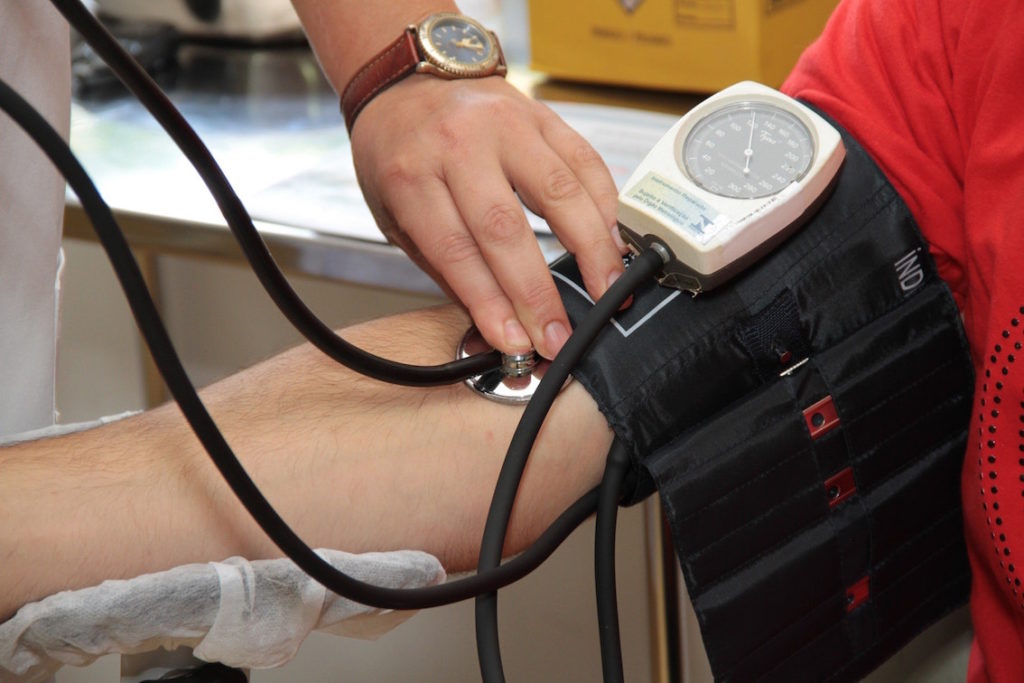In this article, I share four underlying causes of hypertension (high blood pressure) from a Chinese medicine perspective, Including:
- Arteriosclerosis (Blood stasis)
- Atherosclerosis (Blood stasis with Heat)
- Renal hypertension (Kidney Insufficiency)
- Invisible hypertension (Primary hypertension)
Secondly, I share general treatment approaches I use in my clinic.
The Risks of Hypertension
It’s estimated up to 50% of people with uncontrolled hypertension die of heart disease related to poor blood flow. Another third die of stroke.
Stroke can be a risk because high blood pressure damages and weakens the blood vessels through the brain, causing them to narrow, rupture or leak.
In response, the walls of the heart may become thick and enlarged, causing hypertrophy (an enlarged heart)
The following is a list of some of complications from uncontrolled high blood pressure.
- Damage to arteries
- Narrowing of arteries
- Aneurysm
- Coronary artery disease
- Enlarged left side of the heart
- heart failure
- Stroke
- Dementia
- Cognitive impairment
- Kidney Failure
- Kidney Scaring
- Eye blood vessel damage
- Nerve damage (optic neuropathy)
- Sexual dysfunction in men and women
- Obstructive sleep apnea
Chinese Medicine Can Help
Aside from a blood pressure monitor, Chinese medicine has a useful diagnostic tool called pulse diagnosis that gives additional information about the state of a person’s vascular system.
In fact, the left radial artery has a treasure chest of information that tells us about the condition of the heart.
But, you might be wondering… we have scans and blood tests. Why do we need pulse diagnosis?
The answer is simple.
Scans and blood tests can appear normal, yet a patient can still have serious problems. Such problems can include up to 70% blockages through the coronary arteries.
Scans and blood tests can detect serious issues, however they also miss a lot of information leading up to that point.
The reality of western medicine is it’s an emergency medicine. However, the focus isn’t always on getting you healthy.
It’s about stopping you from dying.
For example a cardiac treadmill stress test can detect 70% or more blockages through the coronary arteries.
However, If a patient passes by only having a 50% restriction through their coronary arteries, does it mean the patient’s heart is healthy?
No. They’re just not diseased enough yet.
Chinese medicine is different, it’s focus is on the underlying problems before they turn into late stage problems.
Underlying Causes
As an Australian, it took years studying Chinese medicine to switch my focus from symptoms to underlying problems.
In Chinese medicine, we have to almost ignore the symptoms and focus on treating the underlying problems.
This is because Chinese medicine is hell bent on treating underlying issues that cause symptoms, rather than focusing on the symptoms themselves.
This is why taking a Chinese medicine’s promoted for high blood pressure is too un-specific to do you any good.
A proper diagnosis has to be made.
So, in the next part of this article I’ll share four common underlying issues and how I approach them in my clinic.
#1 Heart Blood Stasis (Arteriosclerosis)
“Heart Blood stasis” is a Chinese medicine term that refers to an inefficient flow of blood (Xue), Vital air (Qi) and Nutrient (Ying qi) through the heart.
Clinically, this presents with a high systolic pressure above 140 and normal diastolic pressure , let’s say 75 accompanied with a slow to normal heart rate (60BPM).
When palpating the left radial artery, there will be a small, stiff jump underneath the fingers. It feels stiff and rigid.
Sometimes, you won’t feel a pulse on the surface, just under the skin, instead it will be deeper towards the bone.
This pulse presentation is associated with:
- The hardening of the arterial system
- A stiff vessel wall
- Poor blood flow through the heart.
Patients with this pulse have a high pulse pressure. This just means a more than 40 point difference between the systolic (top) and diastolic (bottom) numbers.
This is commonly associated with arteriosclerosis.
One of the major problems here is that the artery doesn’t expand fully when blood moves through, it’s too stiff.
So, when there’s blood moving through a stiff vessel, it causes blood pressure to go higher.
We want our arteries to be flexible but in this case they’re not. Instead, stiff vessels restrict the flow of blood moving through the arterial system.
In addition to these changes, the heart rate is often slow relative to the high pressure. This causes blood to move through the vessel at a slower rate.
You might ask, how is blood moving too slowly if blood pressure too high?
Because the tube is either clogged up or too stiff and doesn’t expand when blood flows through.
This is called heart blood stasis and requires Chinese medicine that circulate blood through the blood vessels (blood movers). Some examples include:
- Xue Fu Zhu Yu Tang
- Dan Shen
Also herbal medicine that softens the vessel wall, such as:
- Kun Bu
- Hai Zao
- Shan Zha
In Western medicine an ACE inhibitor can be used to soften the vessel wall or angiotensin based drug may suit.
#2 Blood Stasis with Heat (Atherosclerosis)
This is a different form of blood stasis caused by plaque build up inside the arterial wall.
Plaques can develop at a young age in the aorta of the heart.
Overtime the disease moves into the coronary arteries. Later in life, it get’s into the cerebral arteries and memory declines.
Clinically, it’s seen in patients with a high systolic pressure (140+) and a high diastolic pressure (90+) with a fast heart rate (80+BPM).
When palpating the radial artery it feels thick, swollen and spongy. This represents a narrowing of the inside of the vessel wall due to inflammation and cell proliferation.
Basically, It’s an inflammatory disease inhibiting blood flow through the arteries.
These patients also have fatty livers, poor circulation through the liver, are prone to type 2 diabetes, cardiovascular disease and have a higher risk of heart attack.
A high sugar diet and cigarette smoking are considered common causes of this situation.
How? As sugar breaks down into glucose, it makes the blood thicker.
When there’s thick blood circulating through the arteries, it creates a sandpapering effect on the inside of the vessel wall and the artery becomes inflamed.
As protection, tissue grows over the inflammation and the inside diameter of the vessel wall gets smaller.
In Chinese medicine, this is blood stasis and heat (a descriptive word for inflammation). The ideal treatment will include blood moving herbs. Some examples include:
- Xue Fu Zhu Yu Tang
- Dan Shen
- San Leng
- E Zhu
- Wang Bu Liu Xing
Alongside heat clearing herbal medicines such as:
Ba Zheng San, Zhen Zhu Mu, Ci Shi, Cha Chi Huang and Huang Lian, mu dan pi, hu zhang and more .
In western medicine beta blockers, channel blockers, or even anti-inflammatories may work.
#3 Kidney Insufficiency (Renal Hypertension)
High blood pressure can also be caused by a blockage in the small capillaries and/or the larger arteries in the kidney. It could also be arteriosclerosis in the vessels of the kidney.
The result is usually sharp blood pressure fluctuations.
One major issue here is that blood flow can’t get through the kidney easily, which indirectly raises blood pressure.
This can be identified via the radial artery. For example, a patient can look bright and strong on the outside, but the radial pulse will feel very weak.
The key sign is the radial pulse is weak in all positions but the brachial pulse at the elbow is pounding strongly.
According to Chinese medicine this represents a blockage of blood flow through the kidney.
So, the vessels around the heart may not have hardened but the small arteries in the kidney have hardened or closed. This can lead to water retention.
Herbal diuretics and blood movers are used to circulate blood back through the kidney and clear excess water.
Possible Chinese medicines may include:
- Ba Zheng San
- Di Long
- Dan Shen
Another strategy is to warm the kidney to widen the vessels and improve the EGFR filtration rate with Chinese medicines such as:
- Yin Yang Huo
- Xian Mao
- Si Ni Tang.
In Western medicine, patients are medicated because creatinine levels are usually high. Diuretics may be given.
#4 Invisible Hypertension
As the name suggests, the cause of this type of high blood pressure is difficult to identify.
In western medicine it can be called primary hypertension because no cause has been found. From clinical experience, this is most common in thin patients.
When palpating the radial artery, the pulse is thin and feels very tight. This is accompanied with cold hands, tiredness and fatigue.
This can be dangerous because these people feel so tired that they take energy tonics, which increase their blood pressure further and even damage their heart.
In Chinese medicine, Chinese medicines such as:
Yu Jin and Du Zhong combined in equal proportions can be used.
These support blood through the heart and warm up the kidney at the same time.
Other Factors
If blood pressure is high accompanied with fluid retention on both legs and feels tired all the time. This is a signed the heart is congested.
Adding 50-100g of Mao Dong Qing can work well by clearing excess fluid build up from the chest and supporting blood flow through the heart.
+ Constricted vessels (Vasospasm)
When the radial pulse is extremely thin, like a small wire, it’s like a traffic jam inside the body. A four lane highway of blood is being directed into 1 lane.
This patient can get periodic spike sensations in the chest.
The tighter and thinner the pulse the more severe the constriction is. Chinese medicines that expand the vessels (vasodilators) provide the best outcome.
Some examples include Dang Gui, Chuan Xiong or Sheng Ma into the prescription.
What is Optimal Pressure
Historically, stage one hypertension in the US was 160/100 but was reduced in 1996 to 140/90.
In the early 2000’s it dropped to 120/70.
- Pre-hypertension is defined as a systolic pressure between 120 to 139 or a Diastolic pressure between 80 and 89.
- Stage 1 hypertension is a systolic pressure between 140 to 159 and a diastolic between 90 to 99.
- State 2 Hypertension is a systolic of 160 or higher and a diastolic of 100 or over.
- Hypertension crisis (emergency care needed) is a systolic pressure higher than 180 or a diastolic higher than 110.
If you’re an adult and over 60 years of age the treatment goal is a systolic pressure of 150 or less and a diastolic of 90 or less.
The difference between the systolic and diastolic pressure (pulse pressure) is also important.
A normal heart rate is considered between 60-80 beats per minute (BPM). In Chinese medicine anything lower or higher than that is considered abnormal.
Many athletes can produce readings under 60 beats per minute. But is it healthy?
Not according to Chinese medicine.
It’s believed that athletes, particularly endurance athletes overwork their hearts and may create long term damage.
On the other hand, a heart rate over 80 BMP is often seen in nervous patients that are prone to anxiousness.
Higher pulse rates of 120BPM at rest with fever can indicate an infection or abscess.
Acupuncture
A number of scientific studies on animals and humans have show acupuncture can reduce high blood pressure.
Most positive research has seen 4 to 13 point reductions using acupuncture.
It’s also been shown to reduce the risk of stroke, peripheral artery disease, heart failure and myocardial infarction.
In my opinion, acupuncture works via stimulation of nerves that send messages to the brain stem.
The brainstem reacts by expanding the blood vessels around the heart, resulting in lower blood pressure.
In my clinic these are the common areas I stimulate that have a reliable track record of lowering high blood pressure.
Note: the area is more important than an exact point.
- St 36, 37,38
- K9,8,7
- Ht 7,6,5,
- P3,4,5
- Ren 14,17
- Ear Shen Men
8 Lifestyle Changes
- Quit smoking. Quitting can help return pressure back to normal and reduce risk of heart disease
- Weight loss (if overweight). Blood pressure can increase as weight increases. Carrying excess weight can cause breathing problems while you sleep and increase blood pressure further. For each kilogram lost, you can expect to drop blood pressure by around 1 point.
- Drinking alcohol can reduce the effectiveness of medication and raise blood pressure by several points.
- Moderate exercise including walking and swimming.
- Increasing potassium rich foods can balance sodium and lessen it’s effect on blood pressure.
- Reduce caffeine. Caffeine can raise blood pressure by up to 10points in people who don’t have it often. It will be something you have to monitor yourself.
- Find ways to resolve distress.
- Drink beetroot juice. Consuming beetroot juice daily can reduce blood pressure from 5-10points. It does this because of it’s high concentration of nitric oxide. Nitric oxide ca help relax blood vessels and dilate them.
Which Exercise is Best?
In recent times we’ve confused physical fitness with physical health.
For this reason many people exhaust their body in the quest to be healthy, but are they?
Fitness is the ability to perform an activity at high level of competence. However, it may not have anything to do with our health.
Excessive exercise such as ultra endurance events may overwork the heart causing scar tissue formation in the left ventricle.
In endurance sports, blood gets stolen from the heart and lung and get’s pumped to the quads.
Often these athletes have strong legs and withdrawn looking chests. In fact, the constant pumping of blood to the extremities leads to an anemic heart.
In contrast, I like to take longevity advice from the oldest people in the world.
The most common answer isn’t intense exercise everyday, but that they lived a regular lifestyle, didn’t eat too much, and prayed everyday.
I’ve never heard them say running marathons was their secret.
Exercises such as walking, qigong, taichi, swimming, strength and resistance training, yoga and the like can be beneficial.
Avoid long endurance events like the plague.
About The Author

David is a registered Acupuncturist and Chinese medicine practitioner in Melbourne, Australia, and is the author of The Pocketbook guide to Chinese medicine.
Connect with me on Facebook, Instagram and YouTube
If you got value from this article, please comment below!
Sharing is caring!

